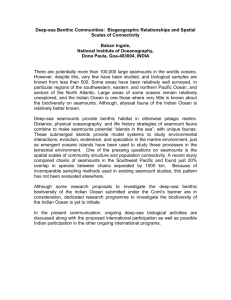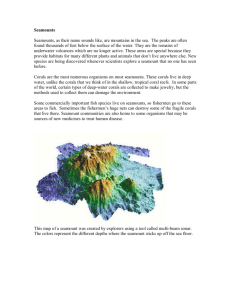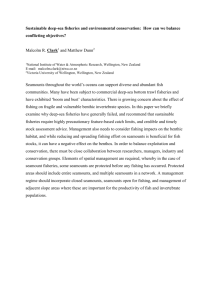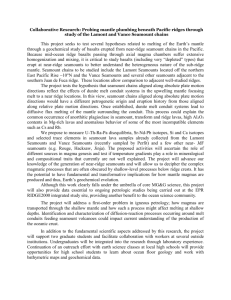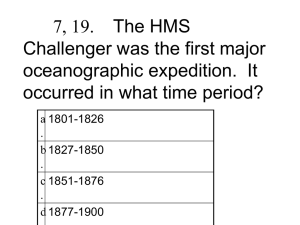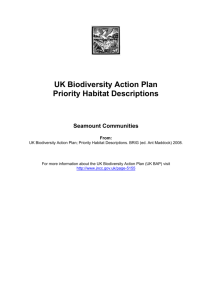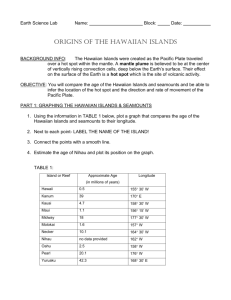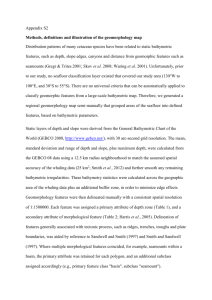Are seamounts like oceanic islands for fish diversity and speciation
advertisement
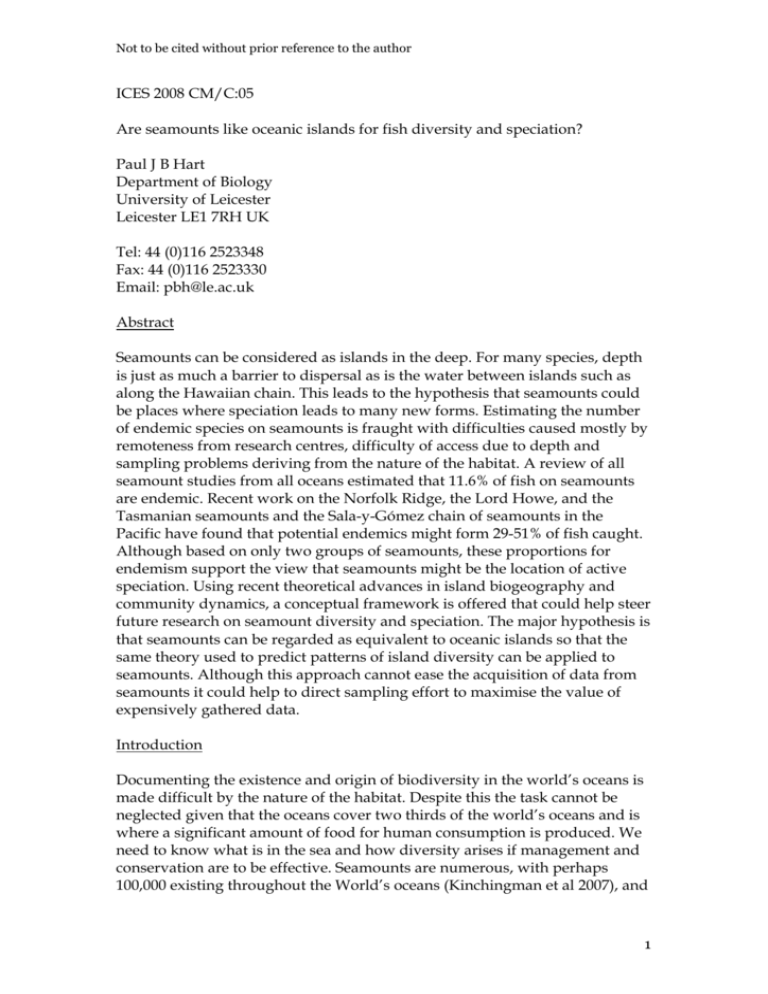
Not to be cited without prior reference to the author ICES 2008 CM/C:05 Are seamounts like oceanic islands for fish diversity and speciation? Paul J B Hart Department of Biology University of Leicester Leicester LE1 7RH UK Tel: 44 (0)116 2523348 Fax: 44 (0)116 2523330 Email: pbh@le.ac.uk Abstract Seamounts can be considered as islands in the deep. For many species, depth is just as much a barrier to dispersal as is the water between islands such as along the Hawaiian chain. This leads to the hypothesis that seamounts could be places where speciation leads to many new forms. Estimating the number of endemic species on seamounts is fraught with difficulties caused mostly by remoteness from research centres, difficulty of access due to depth and sampling problems deriving from the nature of the habitat. A review of all seamount studies from all oceans estimated that 11.6% of fish on seamounts are endemic. Recent work on the Norfolk Ridge, the Lord Howe, and the Tasmanian seamounts and the Sala-y-Gómez chain of seamounts in the Pacific have found that potential endemics might form 29-51% of fish caught. Although based on only two groups of seamounts, these proportions for endemism support the view that seamounts might be the location of active speciation. Using recent theoretical advances in island biogeography and community dynamics, a conceptual framework is offered that could help steer future research on seamount diversity and speciation. The major hypothesis is that seamounts can be regarded as equivalent to oceanic islands so that the same theory used to predict patterns of island diversity can be applied to seamounts. Although this approach cannot ease the acquisition of data from seamounts it could help to direct sampling effort to maximise the value of expensively gathered data. Introduction Documenting the existence and origin of biodiversity in the world’s oceans is made difficult by the nature of the habitat. Despite this the task cannot be neglected given that the oceans cover two thirds of the world’s oceans and is where a significant amount of food for human consumption is produced. We need to know what is in the sea and how diversity arises if management and conservation are to be effective. Seamounts are numerous, with perhaps 100,000 existing throughout the World’s oceans (Kinchingman et al 2007), and 1 Not to be cited without prior reference to the author they are analogous to oceanic islands but embedded entirely in the aquatic realm. The fauna and flora of oceanic islands are of great interest to those who want to understand the origin of biodiversity, and endemism is a characteristic of many of these islands (Whittaker and Fernández-Palacios, 2007; Grant & Grant, 2008; Price, 2008). As seamounts share many characteristics with oceanic islands they could be sites for high levels of endemism. In this paper, I plan to examine the evidence for this hypothesis as it relates to the fish fauna and to outline the data that would be required to test it. At this stage, so little is known about the fish on seamounts, that definitive tests of ideas are as yet out of reach. A second hypothesis that will be used to aid thinking is that birds are the terrestrial equivalent of fish in the marine environment. There are clear differences between the two groups, the main one of which is the size, number and mobility of eggs and young. This difference has significant consequences for distribution but in many other respects the two groups live in a medium that presents the organism with similar problems. Both groups contain organisms the populations of which are distributed on a similar spatial scale between 102 to 104 km (Dawson and Hamner, 2008), and organisms in both have to contend with moving in a fluid medium. Seamounts as underwater islands As with many oceanic islands, seamounts are most often the result of volcanic activity. The volcano was just not big enough to push material above sea level. Some seamounts are also the remnants of volcanic oceanic islands that have been destroyed by erosion (Price and Clague, 2002). Volcanic islands can reach significant altitudes above sea level but during the period immediately after the eruption the island begins to sink as the weight of material depresses the earth’s crust (Price and Clague, 2002; Wessel, 2007). The same will happen with volcanoes that do not break the sea surface but still achieve a great height above the sea floor. Seamounts that are 2-3,000 meters are not uncommon. This gradual sinking is likely to be as important for speciation on seamounts as it is on islands. The rapid period of sinking can last for about 1 Ma and can reduce the height of the seamount by 1000 to 1500 m (Price and Clague, 2002). Whilst an island exists there is a sharp demarcation between the terrestrial and marine habitats. This has obvious consequences for the biota in that it sets a limit to their distribution. At first consideration, a seamount does not appear to have these sharp limits between one habitat type and the next but this perception is more a result of our land based viewpoint than the biological reality. Marine organisms are just as limited in the conditions they 2 Not to be cited without prior reference to the author can tolerate as are terrestrial plants and animals and conditions in the sea change rapidly with depth (Mann and Lazier, 2006, Ch 3). For a start, light only penetrates to at most around 200 m which restricts productivity to the surface layers of the ocean. Below 1000 m any organism has to obtain its food either from other denizens of the deep or from organic material falling from the euphotic zone. For these reasons, a seamount that has it’s top 200 m in the euphotic zone will be a very different habitat from one that has its peak at 800 m depth. For the purposes of this paper, seamounts that project into the euphotic zone only will be considered, as it is most likely that only these seamounts have biodiversity that is high and dynamic. The 500 m depth mark will be considered equivalent to the sea/land interface characteristic of an oceanic island. In this sense, the tops of seamounts projecting into this zone can be thought of as islands (Figure 1). Taking the analysis one stage further it could be said that there is a continuum from a volcanic structure that has its top projecting beyond the sea surface to a low hump near the sea floor with a height of only a few hundred metres. This continuum will have a gradation of conditions for life with two sharp boundaries; the split between the gaseous and liquid fluid bathing the flanks of the volcano and the boundary between the illuminated and dark region of the liquid realm. Spatially the biota on these subsurface islands will be subject to the same factors that influence the biota on terrestrial islands in the sea. They will be separate from other islands and from continental shelves in the euphotic zone and they will be exposed to immigration of organisms from these other locations. Equally, some of these seamounts will be expected to gradually sink as time passes so that eventually their tops pass under the 500 m mark and out of the direct influence of surface events. My analysis applies to these seamount tops, during their existence as islands in the euphotic zone. Theories of island biogeography The first, and still the most cited, theory which attempts to explain the number of species found on islands is by MacArthur and Wilson (1967). Their hypothesis was that the number of species on an island was determined by the balance between species arriving by immigration and species becoming extinct. The basics of their theory are shown in Figure 2, now a textbook figure. Elaborations on this theory have been numerous but the work of Hubbell (2001) and most recently Whittaker et al., (2008) have taken the theory several steps further. This paper is not the place for a full explanation of this new work, but a brief outline is required to make the rest of the paper understandable. Hubbell’s (2001) theory and that proposed by Whittaker et al., (2008) are related to each other and both derive from the MacArthur and Wilson’s (1967) theory. The latter is a neutral theory meaning that the rates of immigration to an island and extinction of species on it are the same for all species. This 3 Not to be cited without prior reference to the author simplification means that no species is better or worse at getting to an island. The additional variables that influence the number of species on an island are the area of the island and how far it is from the mainland or other source of species. Hubbell (2001) also proposes that immigration and extinction are the same but he applies this to a different level or organisation proposing that the neutrality applies to individuals rather than to species. A further elaboration is to make explicit something that was inherent in MacArthur and Wilson’s (1967) theory but not dealt with properly and that is that it assumed that communities are made up of an eclectic mix of species largely thrown together at random. Hubbell (2001) calls this the dispersal-assembly perspective. This is in opposition to the niche-assembly perspective which argues that the species in a community have been moulded by natural selection to fit a set of niches and that competition and character displacement are the two main mechanisms bringing this about. The niche-assembly hypothesis underlies the process of adaptive radiation which has competition for resources as a main driving force (Schluter 2000). The theory proposed by Hubbell (2001) is restricted to a very specific definition of a community. In his terms an ecological community is ‘… a group of trophically similar, sympatric species that actually or potentially compete in a local area for the same or similar resources’ (p 5). So, for fish this would mean all algal grazers or all invertebrate feeders. The theory would not apply to full ecosystems encompassing both predators and their prey. Although Hubbell (2001) argues that this definition is not as restrictive as it seems, it does lead to the possibility that the scope of his theory will be misunderstood as his definition of a community is so restrictive. The original theory of island biogeography did not say anything about the evolution of species once they had arrived on an island. Evolution is part of Hubbell’s (2001) development as it is of the theory proposed by Whittaker et al. (2008). The latter is tailored to the particular histories that will be experienced by an oceanic island which will exist for a limited period of time. As I am assuming that seamount islands will also last for a limited period of time, it might be expected that they too will be the scenes of speciation. Whittaker et al’s (2008) theory of island biogeography is shown in Figure 3. This theory is labelled as the General Dynamic Model or GDM. As the Figure shows, immigration and extinction are still the important inputs and outputs of the system but now as the island ages speciation rises to a peak and then falls away as biodiversity increases and there are fewer opportunities for new forms. The theory predicts that large remote islands will be dominated by evolutionary change more than will islands closer to source landmasses. Note that the carrying capacity of the island, labelled as K, increases to a peak and then falls as the island is reduced in height and area by erosion and subsidence. 4 Not to be cited without prior reference to the author The GDM has random immigration and extinction events providing basic inputs to an island but then assumes that competition for resources can drive speciation on established islands. Animals or plants found as endemics on only one island are taken as a measure of evolutionary dynamics within an archipelago. It has been argued by Emerson and Kolm (2005 a, b) that there is an association between high species numbers on an island and a high proportion of single island endemics. These authors argue that high diversity leads to increased competition for resources and to greater rates of speciation. To test their GDM, Whittaker et al (2008) devise a regression equation, which predicts that the diversity on an island a given distance from a source of immigrants will be a functions of time and island area. This equation is Diversity = a + b(Time) + c(Time2) + d(logArea) where a, b, c and d are fitted parameters. The predictive power of the equation is tested against data sets from the Canary Islands, Hawaii, the Galápagos, the Marquesas and the Azores. Generally, diversity in the data sets used is well described by the regression. If applied to seamounts the GDM would lead to the expectation that species diversity in a particular taxon would be a function of the age of the seamount, its distance from a source of immigrants and its area. We would also expect to find single seamount endemics although the proportion they form of all endemics might be variable. What information do we have on the diversity and levels of endemism in the fish communities of seamounts? Levels of diversity and rates of endemism on seamounts have been reviewed by Stocks and Hart (2007). At present estimates of species diversity for any group are beset by problems derived from sampling. When attempting to compare seamount and continental margin diversity the latter will usually have been sampled with greater intensity than will the seamounts. Also the sampling gear is more likely to sample the relatively smooth bottom of the shelf margin more effectively than it will the rough and rocky seamount. Seamounts are also under sampled as shown by plots of numbers of species collected against number of samples for 180 seamounts. This is always a straight line for all seamounts sampled so far with no sign of the number of species reaching an asymptote. This implies that we still do not have good estimates of total species for any seamount. 5 Not to be cited without prior reference to the author The data on fish is not yet good enough to examine whether continental margins have more or less species that do seamounts. Equally, species evenness, which provides and indication of whether or not the community is dominated by a few species, cannot be properly estimated. The only indication we have that evenness might be low, is the evidence from commercial fisheries on seamounts, which tend to be dominated by one or a few species. Stocks and Hart (2007) defined endemism as a species that is found on one seamount or a group of seamounts close together and nowhere else in the ocean. It is never possible to be sure that a species is endemic, especially as seamount sampling is so poor. There is always the chance that the apparently endemic species exists elsewhere but has just not yet been discovered. An early survey by Wilson and Kaufmann (1987) found that 11.6% of 449 species of fish from 100 seamounts were endemic. 72% of the data came from just 5 seamounts, so this survey is hardly definitive. Richer de Forges et al., (2000) surveying the Norfolk Ridge, the Lord Howe seamounts and the Tasmanian seamounts in the southwest Pacific found that 29-34% of all fishes caught were new or potentially endemic. Earlier, Parin et al., (1997) had found that 44% of 171 species of fish caught were endemic on the Nazca and Sala-yGómez chain of seamounts in the southeast Pacific. The survey of seamount fishes by Froese and Sampang (2004) estimated that only 12% of fish from 60 seamounts were endemic. An expectation dependent on endemism is that fish that have evolved on just one seamount or a group of closely placed seamounts would be genetically different from fish that are closely related by on distant seamounts. Evidence reviewed by Stocks and Hart (2007) shows no support for genetic separateness although the small amount of data available does not make this a strong solution. What do we know about the ages and areas of seamounts? Both the theories of species diversity proposed by Hubbell (2001) and Whittaker et al., (2008) incorporate speciation as a significant contributer to the number of species that is achieved on an island. For oceanic islands, their life-time determines the time span available for speciation to take place and its rate is predicted to be at its highest some time after the origin of the island and after sufficient immigrants have arrived to bring about interspecific competition and the conditions for an adaptive radiation. On some islands, such as the Galápagos, natural selection can bring about phenotypic change very quickly (Grant and Grant, 2008) and in temperate lakes in British Columbia, Canada, which can be regarded as freshwater islands in a ‘sea’ of land, speciation in threespine sticklebacks (Gasterosteus aculeatus) has occurred within a time span of around 10,000 years (Schluter and MacPhail, 1992). 6 Not to be cited without prior reference to the author Mostly, speciation is given more time and oceanic islands are likely to last at least a million years, assuming that they achieve a considerable size on first origin (Price and Clague, 2002). For seamounts we need to know how old they are and more significantly in the context of this paper, how long does the seamount that starts life with it’s peaks in the top 500 m of water remain there. Wessel (1997) estimates the ages of 8,882 seamounts in the Pacific and shows that ages range from a few to 160+ million years old. This work is not specific enough for the current approach as it does not attach ages to specific seamounts. A study that does is Chaytor et al., (2007) who provide detailed bathymetry and age estimates for 14 seamounts in the Cobb and the Kodiak-Bowie seamount chains. Seamounts in these chains originated from hotspots off the west coast of North America and seamount age increases, with some exceptions, from east to west. The youngest seamount is Bowie off Haida Gwai (Queen Charlotte Islands), British Columbia, at less that 0.7 Ma, whilst the oldest is Patton close to the Aleutian Islands at 29.7 Ma. The seamounts in the Gulf of Alaska vary considerably in height and depth below the surface (Table 1). By the definition used in this paper, most have peaks that are below the euphotic zone. For those with peaks close to the seafloor, it might be expected that most fish species will be of abyssal origin. For the seamounts with peaks that are considerably above the seafloor but nevertheless below the euphotic zone, island conditions could still hold and there would be opportunities for speciation leading to endemism. What is now required is a list of fish species found on each of these seamounts. The database Seamountsonline (seamounts.sdsc.edu) has data for seven out of the fourteen seamounts in Table 1 but there is only one record of single species of a fish. Consequently nothing can be deduced about diversity or endemism. From island biogeography it can be predicted that seamounts closest shelf areas of an equivalent depth might have more species than those far out into the Gulf of Alaska. A further prediction would be that seamounts with larger areas, as indexed by summit area, would have more species than those with small areas. The relationship between species numbers, area and distance are predicted from island biogeography and could mirror what is true of the numbers of bird species on oceanic islands. As argued earlier, birds on islands can be taken as analogues of fish on seamounts. On oceanic islands the number of endemic species of bird is linearly related to the area of the island and the distance the island is from the mainland source of immigrants (Price 2008). Taking an evolutionary perspective, island bird diversity is also expected to be greater on old islands that have existed long enough for adaptive radiations to take place (Grant and Grant, 2008). For seamounts in the Gulf of Alaska the oldest seamounts are also close to the mainland so it is on the seamounts in the middle of the two chains (Denson, Welker and Pratt; Scott 7 Not to be cited without prior reference to the author and Campbell) that one might expect to find the lowest fish diversity but perhaps the highest levels of endemism. The GDM of Whittaker et al., (2008) also predicts that on large remote islands the number of species will be strongly influenced by speciation. Discussion This paper has proposed a conceptual and theoretical framework within which the diversity of fish on seamounts can be analysed and discussed. All we need now is good data! The argument presented depends on the contention that within the sea there are boundaries at different depths that define the patterns of ecological and evolutionary processes. The chief boundary is between the euphotic and abyssal zones, essentially a boundary defining habitats with and without light. The lack of primary production in the abyssal zone defines a trophic regime which is fundamentally different from the trophic opportunities that exist in the eutrophic zone. As a result one might expect different selection pressures to hold and this is born out by the very marked adaptations that deep sea fish have to living in a food poor habitat (Marshall, 1971). These differences mean that in any analysis of diversity on seamounts, depth must be a prime variable considered, but within a given depth zone, I am claiming that the same theory can be used to predict patterns of diversity. Within a given depth zone, seamounts are equivalent to oceanic islands at the surface. A further point to make is that studies of diversity need to take trophic level into account. The main theories of diversity on oceanic islands, particularly Hubbell’s (2001) neutral theory, apply only to organisms at the same trophic level. The theory of Whittaker et al., (2008) is not specific about it’s trophic specificity but as it proposes that competition on an increasingly populated island will lead to speciation, the theory implies that it only treats species living at the same trophic level. The chief problem with any study of diversity and endemism on seamounts is the shortage of data and the difficulty inherent in obtaining it. Seamounts are often remote and hard to get to and it is expensive to carry out surveys at the level of detail required. In addition, the sampling methods most often employed are non-selective and lacking in discrimination with respect to depth and precise habitat. Dredges and trawls just catch a collection of species from between two depths, but there is little chance of obtaining more spatially defined information on the species caught. Remote vehicles with cameras do allow a more detailed survey of the spatial relations between organisms on a seamount, but such equipment is expensive and can only sample small areas as a time. We need good data from many seamounts within an oceanic region before it will be possible to determine whether or not seamounts are equivalent to oceanic islands in terms of their species diversity. The Gulf of 8 Not to be cited without prior reference to the author Alaska seamounts discussed earlier could provide the information required if sampled properly but even with this location, there are too few seamounts at a given depth to test properly any hypotheses about the origins and maintenance of diversity. The thoughts expressed in this paper are just a start to the problem of understanding what the level of species diversity is on seamounts and whether seamounts are centres of speciation. The analysis presented is unsatisfactory because there is so little good data making it impossible to test the ideas proposed against the state of nature. From the point of view of conservation and management of seamount fish, we should be thinking in terms of closing all seamounts to exploitation until we understand their status more fully. At present we have only a weak scientific basis on which to plan conservation and management (Pitcher et al., 2007). 9 Not to be cited without prior reference to the author References Chaytor, J. D., Keller, R. A., Duncan, R. A. and Dziak, R. P. (2007) Seamount morphology in the Bowie and Cobb hot spot trails, Gulf of Alaska. Geochemistry, Geophysics, Geosystems, 8 (9) doi: 10.1029/2007GC001712. Dawson, M. N. and Hamner, W. M. (2008) A biophysical perspective on dispersal and the geography of evolution in marine and terrestrial systems. Journal of the Royal Society Interface, 5, 135-150. Emerson, B. C. and Kolm, N. (2005a) Species diversity can drive speciation. Nature, 434, 1015-1017. Emerson, B. C. and Kolm, N. (2005b) Emerson and Kolm reply. Nature, doi:10.1038/nature04309. Froese, R. and Sampang, A. (2004) Taxonomy and biology of seamount fishes, In: Seamounts: Biodiversity and Fisheries (eds. Morato, T. and Pauly, D.). Fisheries Centre Research Reports, 12 (5), 25-32. Grant, P. R. and Grant, B. S. (2008) How and why species multiply. The radiation of Darwin’s finches. Princeton University Press, Princeton and Oxford. Hubbell, S. P. (2001) The unified neutral theory of biodiversity and biogeography. Princeton University Press. Kinchingman, A., Lai, S., Morato, T. and Pauly, D. (2007) How many seamounts are there and where are they located? In Pitcher, T. J., Morato, T., Hart, P. J. B., Clark, M. R., Haggan, N. and Santos, R. S. (Eds) Seamounts: ecology, fisheries and conservation. Blackwell Publishing, Oxford. Ch 2. MacArthur, R. H. and Wilson, E. O. (1967) The theory of island biogeography. Princeton University Press, Princeton. Mann, K. H. and Lazier, J. R. N. (2006) Dynamics of marine ecosystems. 3rd edition. Blackwell Publishing, Oxford. Marshall, N. B. (1971) Explorations in the life of fishes. Harvard University Press, Cambridge. Parin, N. V., Mironov, A. N. and Nesis, K. N. (1997) Biology of the Nazca and Sala y Gómez submarine ridges, an outpost of the Indo-West Pacific fauna in the eastern pacific Ocean: composition and distribution of the fauna, its communities and history. Advances in Marine Biology, 32, 145-242. 10 Not to be cited without prior reference to the author Pitcher, T. J., Morato, T., Hart, P. J. B., Clark, M. R. Haggan, N. and Santos, R. S. (2007) The depths of ignorance: an ecosystem evaluation framework for seamount ecology, fisheries and conservation. In Pitcher, T. J., Morato, T., Hart, P. J. B., Clark, M. R., Haggan, N. and Santos, R. S. (Eds) Seamounts: ecology, fisheries and conservation. Blackwell Publishing, Oxford. Ch 21. Price, J. P. and Clague, D. A. (2002) How old is the Hawaiian biota? Geology and phylogeny suggest recent divergence. Proceedings of the Royal Society, London, 269, 2429-2435. Price, T. (2008) Speciation in birds. Roberts and Co, Greenwood Village, Colorado. Richer de Forges, B., Koslow, J. A. and Poore, G. C. B. (2000) Diversity and endemism of the benthic seamount fauna in the southwest Pacific. Nature, 405, 944-947. Schluter, D. (2000) The ecology of adaptive radiation. Oxford University Press, Oxford. Schluter, D. and McPhail, J. D. (1992) Ecological character displacement and speciation in sticklebacks. American Naturalist, 140, 85-108. Stocks, K. I. and Hart, P. J. B. (2007) Biogeography and biodiversity of seamounts. In Pitcher, T. J., Morato, T., Hart, P. J. B., Clark, M. R., Haggan, N. and Santos, R. S. (Eds) Seamounts: ecology, fisheries and conservation. Blackwell Publishing, Oxford. Ch 13. Wessel, P. (1997) Sizes and ages of seamounts using remote sensing: implications for intraplate volcanism. Science, 277, 802-805. Wessel, P. (2007) Seamount characteristics. In Pitcher, T. J., Morato, T., Hart, P. J. B., Clark, M. R., Haggan, N. and Santos, R. S. (Eds) Seamounts: ecology, fisheries and conservation. Blackwell Publishing, Oxford. Ch 1. Whittaker, R. J. and Fernández-Palacios, J. M. (2007) Island biogeography: ecology, evolution, and conservation. 2nd Edition. Oxford University Press, Oxford. Whittaker, R. J., Triantis, K. A. And Ladle, R. J. (2008) A general dynamic theory of oceanic island biogeography. Journal of Biogeography, 35, 977-994. Wilson, R. R. and Kaufmann, R. S. (1987) Seamount biota and biogeography. American Geophysical Union Geophysical Monographs, 43, 355-378. 11 Not to be cited without prior reference to the author Table 1. Depth and age of fourteen seamounts in the Gulf of Alaska. Figures in italics and names with an asterisk define those seamounts that have peaks and all or part of their plateaus within 500 m of the sea surface. From Chaytor et al., (2007). Seamount Bowie* Base depth m 2800 Peak depth m 34 Summit area km2 26 Min plateau depth, m 200 Max. plateau depth, m 250 Denson 3100 946 109 950 1250 Dickins* Welker Pratt 3000 3300 3700 419 759 719 18 104 229 750 730 910 900 Giacomini 3900 648 74 680 730 Ely Cobb* Warwick* Scott Campbell Murray Patton* Marchand 3900 3000 3400 4000 3900 3300 3900 4000 2129 34 489 1005 1029 572 160 1665 9 61 42 19 3 24 2 2200 120 500 1080 1100 600 330 - 2250 260 650 1150 1200 700 430 1885? Age Ma ≤0.7 16.819.7 2-4 14.9 18 19.921 ? 3.3 6.9 ? ? 27.6 29.7 26 12 Not to be cited without prior reference to the author Figures Sea surface 500 metre depth Figure 1. Seamounts as underwater islands. If the 500 m depth level is assumed to be a boundary between the eupohotic and abyssal zones, then the peaks of seamounts above the demarcation depth can be considered as islands. Solid arrows signify potential exchange of taxa between seamount islands within a group. Dotted arrows represent taxa coming in from other seamounts or from shelf areas of equivalent depth. 13 Not to be cited without prior reference to the author Figure 2. The basics of MacArthur and Wilson’s (1967) theory of island biogeography predicting the number of species to be found on an island given the rates of immigration and extinction. Inear and Ifar are the immigration rates for islands that are near to and far from a landmass. Esmall and Elarge are the extinction rates for small and large islands. Sx are the equilibrium numbers of species for the different combinations x of immigration and extinction. 14 Not to be cited without prior reference to the author Figure 3. A graphical representation of the general dynamic model as proposed by Whittaker et al (2008). As in Figure 2, I and E represent the immigration and extinction rates of species. S is the rate of speciation, K is the carrying capacity and R is the realised species richness resulting from a combination of immigration, speciation and extinction. Unlike a terrestrial island, underwater seamount islands would reduce in height mainly through subsidence with little erosion. Undersea landslips could still be possible and there is evidence for these. (From Whittaker et al., (2008)). 15
